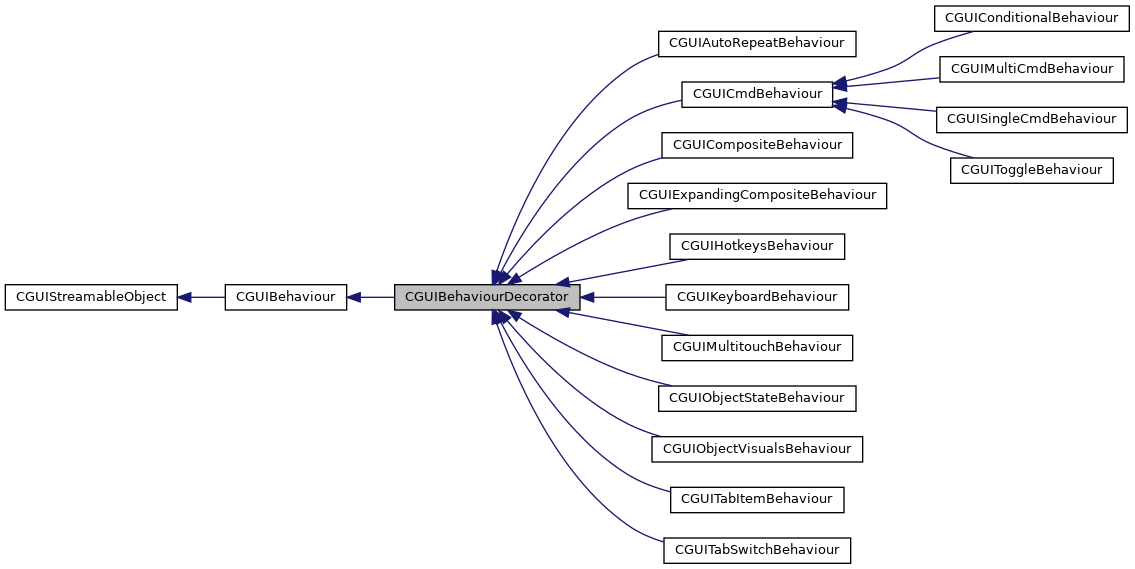|
| virtual | ~CGUIBehaviourDecorator () |
| |
| virtual CGUIBehaviourDecorator * | Clone () const |
| |
| virtual eC_Bool | IsCompositeBehaviour () const |
| |
| virtual eC_Bool | DoScale (const eC_Value &vDelta) |
| |
| virtual eC_Bool | DoUserEvent (CGUIEvent *const pEvent) |
| |
| virtual void | OnCreate () |
| |
| virtual void | OnDataPool (const DataPoolResource_t &eID) |
| |
| virtual void | OnDelete () |
| |
| virtual void | OnHide () |
| |
| virtual void | OnShow () |
| |
| virtual eC_Bool | DoClick (const eC_Value &vAbsX=eC_FromInt(-1), const eC_Value &vAbsY=eC_FromInt(-1)) |
| |
| virtual eC_Bool | DoLongClick (const eC_Value &vAbsX=eC_FromInt(-1), const eC_Value &vAbsY=eC_FromInt(-1)) |
| |
| virtual eC_Bool | DoDoubleClick (const eC_Value &vAbsX=eC_FromInt(-1), const eC_Value &vAbsY=eC_FromInt(-1)) |
| |
| virtual eC_Bool | DoButtonDown (const eC_Value &vAbsX=eC_FromInt(-1), const eC_Value &vAbsY=eC_FromInt(-1)) |
| |
| virtual eC_Bool | DoButtonUp (const eC_Value &vAbsX=eC_FromInt(-1), const eC_Value &vAbsY=eC_FromInt(-1)) |
| |
| virtual eC_Bool | DoDrag (const eC_Value &vDeltaX=eC_FromInt(-1), const eC_Value &vDeltaY=eC_FromInt(-1), const eC_Value &vAbsX=eC_FromInt(-1), const eC_Value &vAbsY=eC_FromInt(-1)) |
| |
| virtual eC_Bool | DoDragEnd (const eC_Value &vAbsX=eC_FromInt(-1), const eC_Value &vAbsY=eC_FromInt(-1)) |
| |
| virtual eC_Bool | DoMouseEnter (const eC_Value &vAbsX=eC_FromInt(-1), const eC_Value &vAbsY=eC_FromInt(-1)) |
| |
| virtual eC_Bool | DoMouseLeave (const eC_Value &vAbsX=eC_FromInt(-1), const eC_Value &vAbsY=eC_FromInt(-1)) |
| |
| virtual eC_Bool | DoMouseMove (const eC_Value &vAbsX=eC_FromInt(-1), const eC_Value &vAbsY=eC_FromInt(-1)) |
| |
| virtual eC_Bool | FocusPrevious (CGUIObject *const pRefObj=NULL, const eC_Bool &bSubTreeOfRefObjDone=false) |
| |
| virtual eC_Bool | FocusNext (CGUIObject *const pRefObj=NULL, const eC_Bool &bSubTreeOfRefObjDone=false) |
| |
| virtual void | GetFocus () |
| |
| virtual void | LoseFocus () |
| |
| virtual eC_Bool | Decrease () |
| |
| virtual eC_Bool | Increase () |
| |
| virtual eC_Bool | DoKeyDown (const GUIKeyIdentifier_t &eKeyIdentifier, const eC_UInt &uiModifiers) |
| |
| virtual eC_Bool | DoKeyUp (const GUIKeyIdentifier_t &eKeyIdentifier, const eC_UInt &uiModifiers) |
| |
| virtual eC_Bool | DoChar (const eC_UInt &uiKey, const GUIKeyIdentifier_t &eKeyIdentifier, const eC_UInt &uiModifiers) |
| |
| virtual eC_Bool | DoScroll (const eC_Value &vAbsX, const eC_Value &vAbsY, const eC_Value &vDelta, const eC_Bool &bModifierActive) |
| |
| const eC_String & | GetXMLTag () const |
| |
| virtual void | ReadFromStream () |
| |
| void | SetXMLTag (const eC_String &kXMLTag) |
| |
| virtual void | WriteToStream (const eC_Bool bWriteClassID=false) |
| |
GUIBehaviourDecorator base class.
Behavioural decorators enable the developer to implement standard object behaviours which are not integral part of a specific control, but can in fact be appended to any CGUIObject. A behaviour's event handling slots are always called before those of its corresponding CGUIObject. You can thus override the object's reaction to a given event without having the need to derive a whole new class for this task. As always, a method's return value indicates whether the corresponding object's event-handling method will still be called (=false) or the event was already completed and no further treatment is required (=true).
The following example shows a simple behaviour decorator which prints out a debug message whenever the GUIObject to which it is attached is being clicked. Note that the DoClick()-implementation returns false, which means that the click will still be forwarded to the corresponding GUIObject afterwards.
You can even attach such a behaviour-decorator to objects which do otherwise not implement any standard behaviour. For instance, you could attach the example behaviour to a CGUIImage-object, let it receive events by calling pPointerToImageObject->SetDisabled(false), and the behaviour will print out a debug-message upon every click on the corresponding GUIImage:
class CExampleBehaviour
{
public:
eC_Bool
DoClick(
const eC_Value& vAbsX,
const eC_Value& vAbsY)
{
GUILOG(GUI_TRACE_DEBUG, "some incredibly impressive clicking behaviour \n");
return false;
}
};
GUIBehaviourDecorator base class.
Definition: GUIBehaviourDecorator.h:78
virtual eC_Bool DoClick(const eC_Value &vAbsX=eC_FromInt(-1), const eC_Value &vAbsY=eC_FromInt(-1))
The following line shows how to attach a BehaviourDecorator to an object:
pPointerToObject->SetBehaviour(new CExampleBehaviour());
Ownership
Note that there is always a one-on-one relationship between a CGUIBehaviourDecorator and its associated CGUIObject OR its parent CGUICompositeBehaviour. That means if you first attach your behaviour to an object within the GUI, and then add it as a child-object to a composite-behaviour, it will be removed from the CGUIObject.
Note also that a behaviour will automatically delete itself if nobody (i.e. neither any CGUIObject, nor any CGUICompositeBehaviour) is still using it!
The following code demonstrates the ownership philosophy
delete pkObject;
This is the Guiliani base class all controls are derived from.
Definition: GUIObject.h:81
void SetBehaviour(CGUIBehaviourDecorator *pkBehaviour)
Execute a command when a specific event occurs.
Definition: GUISingleCmdBehaviour.h:21

 Public Member Functions inherited from CGUIBehaviour
Public Member Functions inherited from CGUIBehaviour Public Member Functions inherited from CGUIStreamableObject
Public Member Functions inherited from CGUIStreamableObject Protected Member Functions inherited from CGUIStreamableObject
Protected Member Functions inherited from CGUIStreamableObject Static Public Member Functions inherited from CGUIStreamableObject
Static Public Member Functions inherited from CGUIStreamableObject Static Public Attributes inherited from CGUIBehaviour
Static Public Attributes inherited from CGUIBehaviour Static Public Attributes inherited from CGUIStreamableObject
Static Public Attributes inherited from CGUIStreamableObject